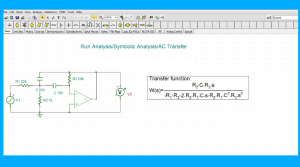Mixed Circuit Simulation in TINA and TINACloud
TINA includes a very powerful mixed mode circuit simulator engine. It is based on the XSPICE mixed mode algorithm, extended with MCU and HDL (VHDL, Verilog, Verilog A & AMS) components. In your circuits you may freely mix any analog or digital components of TINA, including microcontrollers (MCUs) and macros with Spice or HDL content. You can modify these components on the fly along with the code in the MCUs. TINA will analyze the analog parts in analog, the digital parts in digital, and will automatically create the interfaces among the components. This ensures synchronization and fast convergence.
Let’s explore some of the uses of this mode through a few examples.
1. Waveform generation with VHDL and Spice subcircuits
The following circuit generates an analog sine or sawtooth signal depending on the status of the left SW-MODE switch:
The Digital Wave box on the left of the circuit includes VHDL code with a lookup table (Sine_LUT ) for the sine wave and a counter for the sawtooth signal. The essential part of the VHDL code is:
process(Reset, Clk)
begin
if (Reset = '1') then
Wave <= (others => '0');
LUT_index <= 0;
elsif rising_edge(Clk) then
if (Enable = '0') then
Wave <= (others => '0');
elsif (Sel = '0') then
Wave <= Sine_LUT(LUT_index);
else
Wave <= conv_std_logic_vector(LUT_index,5);
end if;
if (LUT_index = LUT_index_max) then
LUT_index <= 0;
else
LUT_index <= LUT_index + 1;
end if;
end if;
end process;
d0 <= Wave(0); d1 <= Wave(1); d2 <= Wave(2); d3 <= Wave(3); d4 <= Wave(4);The digital output of the counter is converted into an analog signal in the 5 bit DA converter of TINA shown in the middle of the circuit. The DAC sine wave output needs to be cleaned up with a low pass filter. We will use a Spice opamp model of the TL081 in a Sallen and Key low pass filter configuration. Press the Enter Macro button on the property dialog and TINA will open the macro. You can review and, if necessary, modify the Spice code inside the macro.
Here are the final waveforms of the full circuit, including the five counter output waveforms. SW_MODE is in the High state, selecting the sawtooth signal:
If we change the SW-MODE switch to Low and run Transient analysis again, the waveforms are:
To see the effect of the analog filter, delete curves d0 to d4 from the diagram by clicking the curves and pressing the Del key:
2. MCU controlled SMPS circuit
The mixed mode simulator of TINA not only allows MCUs, but also any linear or nonlinear parts in TINA’s libraries. As an example, let’s study the following circuit, which realizes a DC-DC converter, converting 5V DC to 13V DC, and operating in boost mode:

3. Mixed circuit example consisting of simple analog and digital components

You can display the results in one diagram or as separate diagrams shown below by simply appending a colon ( : ) and a number to each output name.

Download the FREE trial demo of TINA Design Suite and get:
- One year free access to TINACloud (the cloud-based, multi-language, installation-free online version of TINA now running in your browser anywhere in the world.)
- An immediate 20% discount from the offline version of TINA
- Free license for your second computer, laptop etc.
Click here to download the FREE trial demo of TINA
Dr. Michael Koltai






